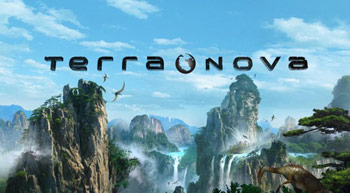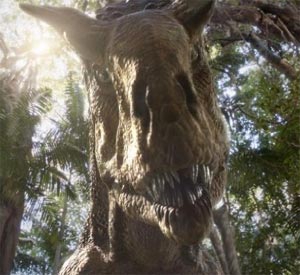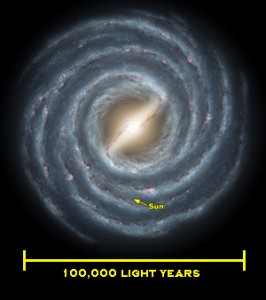So I finally watched the pilot episodes of the new Fox scifi drama “Terra Nova” (it airs Mondays at 8:00 p.m. ET). I found it watchable, with some potential, and like every other TV show in existence (except “Firefly”) it had some things I liked and some I didn’t. I got email about it due to a couple of lines in the pilot, which I’ll get to in a sec. First, a quick overview.
Gotta get back in time
 The idea behind the show (no real spoilers here, since this is all explained in the first minute of the program) is that by the year 2149, the Earth is dying. Pollution, global warming, and so on have made the planet nearly uninhabitable. People need rebreathers just to go outside, and many scenes show huge chimneys pumping smoke into the air just to hammer home that point. Population control is mandatory; having more than two kids is an invitation for the police to come.
The idea behind the show (no real spoilers here, since this is all explained in the first minute of the program) is that by the year 2149, the Earth is dying. Pollution, global warming, and so on have made the planet nearly uninhabitable. People need rebreathers just to go outside, and many scenes show huge chimneys pumping smoke into the air just to hammer home that point. Population control is mandatory; having more than two kids is an invitation for the police to come.
The show centers on a family - cop father, brilliant doctor mother, rebellious teenage son, science whiz-kid teenage daughter, and their youngest, a girl. And yeah, if you count three kids, good for you! That drives part of the plot in Part 1 of the show, so I won’t spoil it.
The big plot device in the show is that a fracture in time is discovered – how and why are not disclosed, perhaps to be revealed in a later episode – that goes to 85 million years in the past. People are being sent back in time to populate the still-clean planet, save humanity, fight dinosaurs, and so on.
I’ll note that I like how the time travel was handled. When we join the story, time travel has already been around a while – this family is sent back as part of the tenth wave of colonists – so the writers didn’t have to spend a lot of time talking about how it was done. It just is. Also, the writers circumvented the inevitable fan rage with a short expository scene stating how this isn’t really our past; the time line has split, so it doesn’t matter if you step on a butterfly or eat an entire herd of dinosaurs. It won’t change the future. That made me smile. Score one (pre-emptively) for the writers.
 Of course, the show tried to distance itself from “Jurassic Park”, and did so by having the first look at the dinosaurs be a herd of brachiosaurs, and then having the main characters in souped-up jeeps getting chased by a carnivorous velociraptor/T-Rex-like animal.
Of course, the show tried to distance itself from “Jurassic Park”, and did so by having the first look at the dinosaurs be a herd of brachiosaurs, and then having the main characters in souped-up jeeps getting chased by a carnivorous velociraptor/T-Rex-like animal.
Um, yeah. Oops.
I’m no paleontologist, and I like watching dinosaurs with big sharp teeth eat a person as much as the next guy, so that part was fine. But then they went a little bit out of their way to add some astronomy, and kinda blew it. So I have to jump in here a bit.
What follows is me nitpicking the science of a couple of lines of dialogue. I don’t do this to be petty – I gave up on that in my reviews a long time ago – but just to use these lines to point out the real science. Any snarking is incidental.
M-O-O-N, that spells MATH
 At the very end of the episode, the family goes outside and sees the Moon hanging in the sky. This was actually a pretty good idea; pollution is so bad by 2149 that it’s been years since the sky was clear enough to even see the Moon. So cool, this is a good way to wrap up the first show and reinforce the idea that things are different 85 million years ago.
At the very end of the episode, the family goes outside and sees the Moon hanging in the sky. This was actually a pretty good idea; pollution is so bad by 2149 that it’s been years since the sky was clear enough to even see the Moon. So cool, this is a good way to wrap up the first show and reinforce the idea that things are different 85 million years ago.
But then they messed up. They show the Moon looming hugely, obviously far bigger than what it is today.
So the little girl asks her big sister, “Is it always so big?”
Big sis: “Not always. It moves about a half a centimeter away from the Earth every year, so it’s much closer than it was yesterday.”
Dad: “You mean ‘tomorrow’.”
Big sis: “You know what I mean.”
OK, the time travel reference was cute; from their point of view they only left the future yesterday. Unfortunately, Big Sis’s math was screwed up.
First, her saying the Moon moves away from the Earth is correct, and her number of half a centimeter per year is close enough; tides from the Earth are indeed moving the Moon away from us currently at about 4 cm/year. That number changes over geologic time, and as it happens the Moon’s moving away a bit faster than usual right now. Millions of years ago that rate was slower*. So OK, let’s go with her number. As you’ll see, it doesn’t matter much.
How much closer would the Moon be that long ago? Well, that’s simple math: it’s just rate x time. So 85,000,000 years times 0.5 centimeters per year = 42.5 million cm, which is 425 kilometers.
The Moon currently orbits the Earth at a distance of about 400,000 kilometers, so that change is tiny, only about 0.1%! Even using the larger, current rate of recession won’t help much. You’d never notice that difference in size with your eye, and to be honest it would be tough with a telescope!
I’ll note that the Moon orbits the Earth in an ellipse, and so sometimes is closer to us than other times. In fact, the Moon ranges in distance over the course of an orbit by about 50,000 km, far more than that steady change over the past 85,000,000 years of just a few hundred klicks. And that’s every two weeks!
So the Moon wouldn’t have looked appreciably different, even 85 million years ago. The family, looking up at the Moon, should’ve simply marveled that they could see it at all.
The fault lies in the stars
Again, to establish how things are different in the past, the Big Sis says, “The stars are all different here too. They’re not in the same place as in 2149, because the universe has had 85 million fewer years to expand. I mean, do the math.”
First, I had to laugh at that last “Do the math” line, given the problem with the Moon I just explained. But still, like with the Moon, they got the situation correct but messed up on the explanation.
Yes, the Universe is expanding. And sure, it was smaller 85 million years ago, but only by a small amount (less than 1%). The thing is, this expansion has nothing to do with the positions of stars in the sky; it only affects things on very large scales, like the distances to other galaxies. Even then, it’s not important for nearby galaxies like Andromeda. You need to look at galaxies even farther away to see it.
 Still, the stars would be different in the past, but it’s because of a local phenomenon: the Sun and all the stars you see are orbiting the center of the Milky Way galaxy. They also go around at different speeds, so their positions in the sky slowly change.
Still, the stars would be different in the past, but it’s because of a local phenomenon: the Sun and all the stars you see are orbiting the center of the Milky Way galaxy. They also go around at different speeds, so their positions in the sky slowly change.
I’ve seen different numbers for the time it takes the Sun to go around the galaxy once, but it’s something a bit more than 200 million years. 85 million is a large fraction of that time, so you’d expect the stars to be very different back then. Plus, some of the stars we see today are younger than that, and weren’t yet born back then… plus, some of the stars you’d see back then would have exploded as supernovae by now. So sure, the stars would look completely different to our time traveling protagonists. But it’s due to the rotation of our galaxy, not the expansion of the Universe.
Come to think of it though, with that late Cretaceous full Moon sitting fat and bright in the sky, it would wash out all the stars, and the family wouldn’t have seen any at all anyway.
Semper sci fi
So all in all, it’s not a terrible show. The writing isn’t bad and the acting is good, even if the special effects could use some work (some of the dinosaurs aren’t as realistic looking as they were in “Jurassic Park” and that standard, like it or not, has been set). The main use of science was handled well, if some incidentals weren’t, and the science is being used to augment but not necessarily drive the story, which is important. I’d give it a B.
So I’ll watch it, because I’m jonesing for straight science fiction. I really liked “Stargate: Universe”, and I miss my spaceships and aliens. There’s nothing like that on TV for at least the next season, so, for now, “Terra Nova” will do. They’ve set up some interesting ideas, and I’m curious to see what they do with them.
Unless a 10-km-wide asteroid wipes out the colony first. But they have 20 million years to see that coming…
* This gets complicated. The rate of recession actually tends to slow with time, but there are other influences, like – seriously – the shape of the continents on Earth (read the link above for more info). We happen to live in a time when the recession rate is unusually high, so a few million years ago it was moving away more slowly… but over looooong periods of time the rate tends to drop.
Related posts:
- BA review: Star Trek
- The Universe is expanding at 73.8 +/- 2.4 km/sec/megaparsec! So there.
- Blastroid
- 5 big-budget sci-fi films that actually got their science right